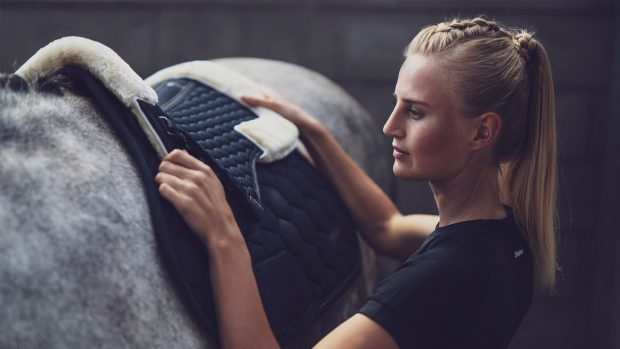How often do you clean your horse’s saddle pads? Every time you use a saddle pad, numnah or half-pad, it will absorb a certain amount of sweat, grime and scurf. This builds up until there are dirt or grease patches, which will harden and can cause sores or rubs on the horse’s back. While the outside of the saddle pad may superficially still look clean – especially if it’s a dark-coloured one – the underside could well be a different story.
As well as keeping your horse comfortable, regular and appropriate cleaning of the saddle pad will extend its life. The salt in the horse’s sweat can break down the fibres in the pad, meaning it will wear more quickly.
Of course, there are no set rules on how often you need to clean it: some horses sweat more, some riders groom less, and it depends on the season and the amount and intensity of the work done.
How you clean your saddle pad yields another set of choices. An everyday dark-coloured cotton pad will have different instructions to a white sheepskin, so let’s aim to cover all the popular options. Most saddle pads will have washing instructions, so you will know if they can be washed in your machine, for example, or need hand-washing.
How to clean your everyday saddle pad
Many riders opt for dark saddle pads for daily use, as they show up the dirt less than lighter colours. Before you start any washing process, brush off or vacuum the hair and as much dirt as possible from the underside of the pad. Next, a washing machine works well up to a point if this is recommended by the manufacturer, but it’s best to avoid using your regular detergent as it contains a bleaching agent which will compromise the fibre and stitching. However, milder detergents may not to shift the grease and grime. Instead – or if the pad is not machine-washable – a good hand-scrub will work wonders to shift stains and stubborn grease spots. Some riders swear by hand-scrubbing with human shampoo, which gets rid of grease without compromising the fabric, with the additional benefit that it won’t fade the dark colours.
Tumble dryers are not recommended. Hang the saddle pad up and allow them to air-dry, without pegs, which can cause awkward kinks in the shape of the pad.
Keeping a saddle pad white
While in most cases you shouldn’t get any extra marks for turnout at a competition, but it certainly helps you look and feel the part to be well presented. Many riders save their white saddle pads for competition days, after which they should be kept separate from all the other, possibly muddy, items bound for the washing machine. And remember not to polish the inside of your riding boots, as black polish is extremely difficult to remove from a white fabric.
As with the dark coloured pads, try to remove as much dirt, grime and hair with a brush or vacuum, and hand-scrubbing with shampoo before using the machine – providing the manufacturer’s instructions recommend this. Remember to check for any rogue red socks in the machine’s drum that might turn your numnah pink, and then wash at the suggested temperature.
Like our own white clothing, you’ll want the saddle pad to be bright white to dazzle the judges. Bleach is a no-no, as it will weaken the fibres and may cause irritation to the horse’s skin. Some people use a traditional whitening trick of soaking their whites in a weak solution of borax for an hour, then rinse thoroughly and leave to dry.
Sheepskin and wool saddle pads
These need a bit more care to keep the wool both clean and fluffy. Check the manufacturer’s instructions, and you will find that many sheepskin saddle pads can be put in the machine, usually on a cool cycle designed for woollens or delicates. Otherwise you’ll need to roll your sleeves and hand-wash in a big sink or a bathtub.
There are several detergents designed for washing sheepskin and wool, such as Mattes Melp or Woolskin detergent. A liquid non-bio product is key as powder can clog up the fibres of the wool. One hot tip is to rub in a generous amount of human hair conditioner before washing, as this can improve the softness if the wool is matted.
Once the pad is clean, brush it with a sheepskin brush, such as the Wool Company’s bamboo one or a dog grooming brush, to revitalise its fluffiness.
Lay the pad flat to dry indoors.
There’s a lot more to cleaning your saddle pads than first meets the eye, but these tips should ensure a smart, professional turnout and a comfortable horse.
You may also be interested to read…

12 great GP saddle pads for everyday riding

8 saddle pads worth pairing with your jump saddle

8 half pads to consider to help perfect your saddle setup

A selection of dressage squares for competition and everyday training

Subscribe to Horse & Hound magazine today – and enjoy unlimited website access all year round
Horse & Hound magazine, out every Thursday, is packed with all the latest news and reports, as well as interviews, specials, nostalgia, vet and training advice. Find how you can enjoy the magazine delivered to your door every week, plus options to upgrade your subscription to access our online service that brings you breaking news and reports as well as other benefits.




